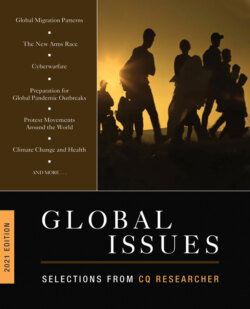Читать книгу Global Issues 2021 Edition - Группа авторов - Страница 37
Shifting Policy
ОглавлениеIn 2005, Mahmoud Ahmadinejad, the hard-line mayor of Tehran, was elected president of Iran. As U.S. troops became bogged down by insurgencies in Iraq, Iran shifted policy and threw its support behind Iraqi Shiite militias fighting the Americans. Over the next four years, the militias killed hundreds of U.S. troops.
When Democratic President Barack Obama took office in 2009, he reached out to Iran in a broadcast. “My administration is now committed to diplomacy that addresses the full range of issues before us,” Obama said.51 The top issue was Iran’s nuclear program, which U.S. and Israeli officials suspected was aimed at developing a nuclear weapon.
But Israel threatened Obama’s diplomatic effort, letting the administration know it planned to bomb Iran’s nuclear infrastructure before it became too advanced. Obama repeatedly dispatched senior U.S. officials to Jerusalem to argue that an attack would spark another Mideast war that inevitably would involve the United States. But Israeli Prime Minister Netanyahu argued that Iran’s response would be limited. Besides, he added, an Israeli strike would not only derail Iran’s nuclear program but also spark the overthrow of the Tehran regime.52
The administration did not know whether Netanyahu was bluffing. So as U.S. spy satellites watched Israel openly prepare for an attack, Obama chose another strategy: secret negotiations with Iran. In late 2010, two top White House aides flew to Oman, where they quietly hammered out a framework for negotiations with Iranian officials representing Khamenei.53
In 2013, prospects for better relations with Iran brightened after moderate Rouhani was elected president and indicated during a trip to the U.N. General Assembly that his government was ready to engage with the United States.54 A few days later, Secretary of State John Kerry and Iranian Foreign Minister Zarif met to discuss how to follow up on the framework agreement reached in Oman.55
Their meeting launched intense negotiations for a nuclear accord between Zarif and Kerry and the foreign ministers of Russia, China, Britain, France, Germany and the European Union. On July 14, 2015, after two years of talks, they signed the Joint Comprehensive Plan of Action (JCPOA), under which Iran agreed to curtail its nuclear program in return for relief from international sanctions. The U.N. Security Council endorsed the deal, giving it the imprimatur of international law.56 The United States, however, kept its non-nuclear sanctions in place.
Israel and Saudi Arabia castigated the accord, noting that it failed to address non-nuclear threats, such as Iran’s ballistic missile program and its support for proxy forces across the region. Trump adopted that view as he campaigned for the 2016 Republican presidential nomination and pledged to withdraw the United States from the agreement if elected.
Trump made good on that promise in May 2018, despite repeated U.N. certifications that Iran was in full compliance with the agreement’s provisions. Six months later, Trump reimposed crippling economic sanctions on Iran, reigniting the hostility and distrust that had poisoned U.S.-Iran relations for nearly 40 years.
